Modern Farmer

Beekeepers fighthive losses asdie-off worsens


Beekeepers fighthive losses asdie-off worsens
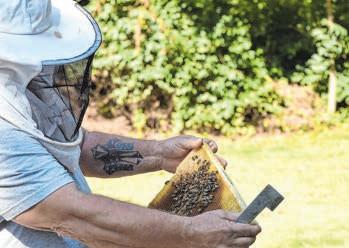

By Samantha McDaniel-Ogletree STAFF WRITER
Awest-centralIllinois beekeeperlost severalof his hives thisspring, losing many beesasthey battledthe weather, mitesand otherdangers.
Dan Keesee, treasurer of the AppleCreekBeekeepers,has hives northof town,as wellas a few out in thecounty. The group helpseducatepeople aboutbeekeeping. It meets the third Thursday of every month at the University ofIllinoisExtensionoffice at104 N. Westgate Ave.
“In the fallof2024,I went intothewinterwith five stronghives,” Keesee said.“In February, we had that realcoldsnap and snow blew intothebottom of thehives,two froze, but Istillhave three strong hives. Then I went outand saw that oneof my hives was beingrobbed, which happens when a strong hive dies.”
This summer was spent workingtoensurehisremaininghives thrived and attemptingto startnew onesinpreparationforthe wintermonths by building hispopulationback up withpurchasedbees,as wellasrelocating a colony fromanold shed. This springhe was back up to five hives.
“Theloseofhives devastatedme,” Keeseesaid. “A lotof workgoesinto thesehives. I didhavea goodspringand my hives werebuilding up fast.”
But thecauseofthe death ofhisbees,hebelievesisthe weather, anill queenbeeandthegrowing useofpesticideson plants.
And he’s notalonein the loseofhisbees.
Project Apism.isa grassrootscollaboration
betweencommercialbeekeepersandalmondgrowers. Accordingtothe group,there was an average loseof62%ofbeecoloniesamongcommercial operationsbetween June 2024and February 2025. Theyestimatedthere were just over 1.6 million colonieslost acrossthecountry.
In Illinois,commercial beekeepers(morethan 500 hives) lost an average of 46.8%,sideliners(50500 hives) lost an average of 77.1%,andhobbyist (1 to 49 hives) lost an average of 63% between June2024 and March 15, 2025. Accordingtothe study, parasites,pathogens,pesticidesandpoor nutrition are theleadingcauses of the declineinthebeepopulation.
For Keesee, thedrought has causethebeesinseveralofhishives to decreaseproduction offood that wouldbe stored during thewinter, andinstead theyare startingtouse their storedfoodtoensure theyarefedasthereisa decreaseinpollenproductionwiththelittlerainin the past severalmonths.
That couldimpacthow many ofhisbees survive the winter.
To ensuretheyhave adequate stores,hehasbegun providingfoodfor themthat willallow them to keep what they’ve stored and increase it
This year, Keeseesaid he isreally tryingtofind the best way toprotect his bees duringthewinter. Whilemost beepackages comefrom thesouth wheretherearen’t harsh winters, Keeseesaidbees herehave to adapt, store foodand work togetherto heat theirhives.
“In thewinterthey cluster aroundthe queento keepher warm,” Keesee
said. “Thebeesusetheir wings toproduceheat to heat thehives. If you don’t have a strongpopulation or goodhive, theycan freeze and die.”
The risk of a decreased bee populationisn’t just in the lose of honeyproduction,butcouldhave far reachingimpacts.
If pollinatorslike bees die off it would impactthe growthofmany different crops.
Accordingto a presentation by Project Apism., 75% offoodcropsand 35% of the global agricultural production volume dependsonpollinatorslike honey bees.
Beesarenature’s pollinators,carryingseedsand pollenfrom oneplant to another, helpingtoproduce plants,fruits, vegetablesandtrees,said Ken Johnson,horticulturaleducatorfor the University of IllinoisExtension in MorganCounty.
“Beesareimportant pollinators, especially for specialtycropslike veggiesandfruit,” Johnson said. “Theseplantsneed pollinators. If theydieoff, plant production decreases. It’s a trickle downeffect. Thankfully, we are not at that point yet.”
Johnsonsaid while it is difficulttomonitornatural population,in general, the beepopulationhas beenonthe decline.
In order toensurethe growthofthebeepopulation, Keeseesaidbeekeepers especially, needto monitortheirhives for anythingwrong, whether it bemitesthat have latchedontothebees.
Keeseesaid a strong queenwill keep a hive alive, producing 1,500to 2,000eggs a day. That slows as she agesand she willlay anegg tobecome a
FrompageA2
queenonce she istwo old.
Therearealsocases where a hive is doingso wellthe queenwillgrown anewqueen,take halfthe hive populationandestablish a new hive elsewhere
But,hives facetheir own predators.
One ofthebiggest is mites, which attach themselvesto thebeesandwill beginto kill offthebees.
Keeseesaid beekeepers use variousmethodsto treat formites,from using powdered sugar which causesbeesto cleanthemselvesand detach the mites,to chemicaltreatments.Beesalso facebeetlesthat raidthehives,as wellasdiseaseslike Americanfoulbrood.
Johnsonsaidoutside of the climate changesand
weatherinterference, bee populationsalso faceproblemsfrom humans. For thosethat usepesticides to protecttheirgardens from insects,their use of chemicalcancausebeestobecomeill.
To protectthe population, Johnson saidgardeners shouldtake thetimeto study theirgardens,find out what iscausingproblemsandfind ways totreat for thosethat wouldn’t impactbees.
He saidpeoplecan also helpbuild up thehabitat for thebees, addingpollinatorgardensiftheyhave the space. Keeseesaidthe world needsbeesforhoney butalsoforpollination.
“Localhoneyhasno preservatives and it helps withallergies,” Keesee said.“Beesbringinpollen and it helpspeoplebuild up theirimmune system to stufftheyareallergicto.”
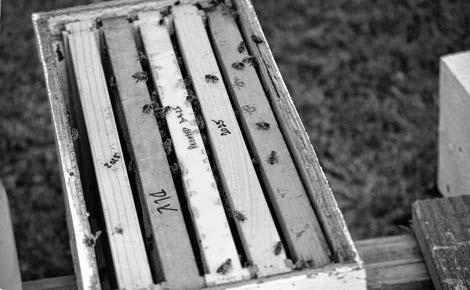
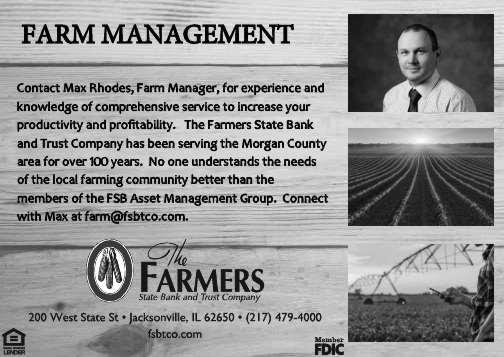

By AngelaBauer STAFFWRITER
One needlooknofurtherthantheinternetto findtheviral evidenceof just how much people love a cuteanimal.
But while dogs andcats still rule, plentyofother animalsare entering the companion-animalconversation.
Includingsomeonce considered strictly “wild” animalsorlivestock.
Jenny Charlesworthof Concordhas few limits when it comestopets, which is why she now owns a youngraccoon.
“It’s likea dog-bearcat-toddler, allthethings in one,”Charlesworth saidoftheraccoon, which she named Willow. “I’m just animpulsive person. Ialways wanted (a raccoon),but I knew it was illegal.”
Withan“aw, well,” she resignedherselfto a raccoon-lesslife.
“Then I foundout you just have to apply for a licenseand get them througha breeder,” Charlesworthsaid.
It wasn’t longbefore she had donejust that. She now holds a furbearing animal license, which

CourtesyofJennyCharlesworth
Willow, a young raccoon,playsat thehomeof JennyCharlesworthofConcord. Charlesworth, whohasseveralpets,hadalwayswanteda raccoon, shesaid,so she got the requiredlicense to makeitpossible.

also wouldallow her to own otherfurbearinganimalsinthe state, including redfoxes.
“I didn’t raiseher from ababy,” she saidof Willow, “so it’s a slow process of bondingwithher. She’s still a little standoffish, but every day she getsa littlemoreaffectionate.”
Charlesworth studied to bean elementary schoolteacherbutnow owns The BoujeeBarn women’s clothingboutique onthe downtown Jacksonvillesquare She and her husband,Aaron, have two daughters,Braxton, 10; and Rees, 9.
She loves havinga range ofpets,too.
“I’ve just always been an animalperson,all my life,” she said.
To go with Willow, the Charlesworthhomeincludes anindoorcat,six barncats, a Chihuahua,a St. Bernardandtwo beagles. She’s previously owned a chameleon,an axolotl “thosesalamander fishy typethings” —a guineapigandan Indian ring-neck parrot. The parrotnow lives withher sister.
Whilesomeofher pet choicesaren’t typical, petsbeyondthenormare becoming, well,morethe norm.Or, at least,lessuncommon.
Accordingto Forbes’ pet ownership statistics for 2025,66%ofhouseholdsinthe United States owna pet,with dogs and catsleadingthe way. Other popular choices include freshwaterfish; smallanimals such as hamsters, gerbils,rabbits,guineapigs,mice and ferrets;birds;lizards
and turtles. Petmd.com addshorses tothelist,notingin 2023that the numberof householdswithhorses roughly tiesthe number of householdswithfish, and PetHelpful.comincludes poultry in its top 10.
The internethasmade evenmoreunusualanimalsinto overnight celebrities. Moo Deng,a pygmy hippopotamusborn in July 2024, at Khao Kheow Open Zoo inSiRacha, Chonburi, Thailand,took the world bystormafter the zoopostedto its Facebookpage pictures ofthe then-baby hippo.
Not too far away, anannual water buffaloconservationday, heldthis yearonOct. 6, included buffaloracingand a beauty pageant forthemassive animals.
Theirrole inhelpingto plow farmfieldslargely displaced by farmmachinery, the Thai government createdtheday, the festivalandbeautypageants tohelpcombata declineintheanimal’s population.
Many ofthe ownersentering water buffalointhe festival’s beautypageant saidthey grew up with the gentleanimalsand still value them, evenif it no longermakes senseto use themfor farm work.
“Although buffaloes can still work inthefield, theycannotcompetewith machines,”said ThawatchaiDaeng-Ngam,a food vendorand farmer whose family still keeps 30 buffaloes,including Tod, a beautypageant contestant.“Buffaloes are
By BenSingson STAFFWRITER
Many peopledrive past or fly over fields upon fieldsof farmland.
But about60million Americans roughly one in five people call those fieldshome. And growing up inthat kindofplace leavesanindeliblemark on them,regardlessof where they go or what theyend up doing.
PatriciaBoldt grew up on a dairy farmoutside of Pearl City, where she lived fromtheday she was born until she leftforcollege at 18. She remembersher fatherneeding to wake up to milkthecows around5:30 a.m.each morning, herself and hersiblings getting up not longafter. Her father wouldleave thehouseto milkthem againaround4 p.m., a schedule which he fastidiously maintained, she said.
“My dad was onepolitical partyand his father-inlaw was anotherpolitical party,”Boldt said. “Grandpa andGrandma would comeout about 3 p.m.orso and Dad andGrandpa would startarguing. At4 o’clock, Dad just got up and leftandGrandpaalways thought he won theargument.”
In betweenmilking cows and doing chores, Boldt wasa memberof multiple clubsand church groupsforfun. She hada difficulttimeselectingher favoritething aboutgrowing up rural,butonething she didmention was having theopportunityto learn abouthow life works firsthandwithher family farm’s animals.
“Youlearn aboutso
many things that kidsin town don’t learn aboutbecause you see lifeas it really is,”Boldt said.
As for Jenny SauerSchmigdall, she lived incities all overthe United States. But Sauer Farmsin ScottCounty was where she was raisedand where she callshometoday. For her, day-to-day life was “different every day”and always had work that needed to get done.
“There’s always work to be done,” she said. “There’s always something to fixandalsotoexplore.”
On her family’s farm, Sauer-Schmigdallexplored thewide-open spacesandnature availabletoher, as wellas things like driving at age10. Her favoritepartof growing up in a ruralenvironment was thefreedom to what she wanted.
“We had freedomto do pretty much anythingthat we feel like doingand (didn’t) have to dealwith neighborscomplaining,” she said.
The rural lifestylecanbe fascinatingforthose who grew up inurbanenvironments.Sauer-Schmigdall has brought peoplefrom the citytoher farmand foundthat inher experience, urbanitescannot wrap theirhead around just how much openspace afarmhas. She also said that people who grew up in citiesare “farremoved” fromknowinghow to grow things becausethey don’t needtobeself-sufficient— everythingthey needisthetouch of a button away.
“Onepersonsaid,‘Wow ... when you say farm,this is where it all starts It
startsgrowinghere,’”
Sauer-Schmigdallsaid. “I’m like, ‘Yeah.’”
Boldt echoedSauerSchmigdall’s sentiments aboutopenspacesandalso saidthey were“amazed at how much you cansmell.”
Havingfriends who grew up intown overgave hera chanceto show offher knowledge she had gained on the farm,including identifyinghogs orcattle by aroma alone.
“NotthatI want to show off, but it doesgive a better understandingoflife,” she said.
Boldt nolongerlives on afarm,instead residingin Chapin. If there was anything she missed aboutliving on a farm, it was the “senseof accomplishment whensomethingis done right.”
“When you do the chores, whether it’s inthe gardenor whether it’s on the dairy farm part or whatever,” she said, “when it’s done, it’s done, and you know how it’s done.”
Sauer-Schmigdall, meanwhile, never spent morethanthreemonths away fromhome, even while she was livingoutside ofIllinois. She rememberstheexact moment she realized she wantedtoreturntoher family’s farm full-time:sittingin a guest houseinthe Los Angeles area. She realizedthat she felt“truly happy” when workingonthe farmwith her family, likening it toa Hallmark movie.
“I just thought, ‘Every timeI’m home,I don’t want toleave,’ ” SauerSchmigdallsaid. That enthusiasmhas beenpassed downto


By RhiannonBranch FARMWEEK
AtriptoSouth Koreato strengthentrade relationshipsisfreshonthemind ofIllinois Pork Producers AssociationPresident JoshMaschhoff.
“Therearen’t enough positive attributesthatI canthrowoutherethat would describehow awesomethetrip was, it was j.t a wealthofknowledge,” Maschhoffsaid aboutthe triphe attendedwiththe U.S. Meat Export Federation,representingthe National Pork Board.
“Igainedperspective seeinghowthe Korean peopleandoneofthe U.S.’s largerinternational consumers,useourproducts. Thecultureofhow theyusethatproductand get it totheirconsumersis significantlydifferent.”
Maschhoffsaidthat South Koreais aboutthe sizeof Indianabutwitha densepopulationof about 52million. Withlessopen landpeoplethere don’t have asmanyopportunitiestogrowtheir own food,andthoselivingin high-risebuildingsare workingwithsmallkitch-
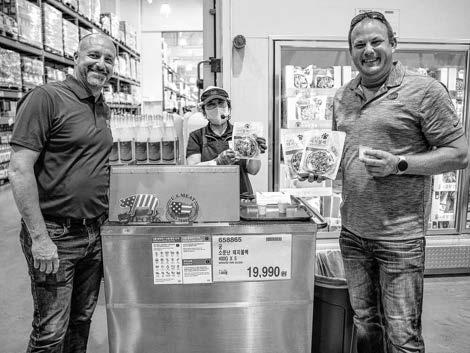
ensandinconveniences travelingtoeatout.
“Right now, Koreais drivinga huge sector

calledhomemealreplacement,”hesaid.“It’s about tryingtotakethedifferent segmentsof yourbalancedmealandbuild themintoaone-stop shop packagethatmight beprecookedoreasy tocook at homewith delivery servicetotheir door.”
South Koreaisthe third-largest export destinationfor U.S. pork musclecuts,reaching$422 millionthrough July.Belly isacut Koreansprefer,but U.S.demandforbacon makes it harderto get,so thecountryisthinking outside ofthebox.
“They’ve donesome very uniquethingslike slicingthe shoulder very thinandsmoking it to get
theircustomersare demandingthe qualityand tasteof U.S. beefandpork.
“They very muchappreciateandhave an alignmentwiththe U.S., looking at the U.S. asa very sustainablesourceof theirbeefandpork,” Maschoffsaid,notingarecent pollthat showed 70%of thepopulationconsiders the U.S. aspositive or favorable.“Iftheyseea U.S. labelontheproductsin the stores,thatcarriesa lotof weight.”
Maschhoffsaidtrade is topofmindforhimas30% of U.S. pork isexported.
“The rhetoricbetween countriesandpotential trade impactbarrierscan reallyaffectthepriceof themarketandlongstandingrelationshipsbetween free accesscountriescan be challenged,”hesaid.“I think it’s importantthat we continuetolook at how to getfreetradeagreementswitheach ofthese externalcountries— that’sreally goingtoimpact demand much greaterthananything we think we can do onthe domestic side.”
not quitethesametexture, butthe flavorandexperienceofbacon,” Maschhoff said.
“It waseducationalfor us,but it wasalso about buildingrelationshipsbecausehavingpersonal connectionsmeansalotto themfromacustomerconsumer standpoint.”
Thegroupvisitedfood serviceandretaillocationsincludingCostco and E-Mart,touredthe Portof Busan,and keyimportingcompanies such as Fresheasy, Frank Burgerand Highland Foods.
TheCEOof Highland Foodsspecifically wanted tohosttheteamtobuild relationshipsdirectly with U.S. farmersbecause
The Maschhoffs work with about 350production partner familiestoraise about3millionmarket hogsa year. Maschhoff said favorablehogprices andlowerfeedcostsare highlightsofhogproductionthis year,butthere aresomeheadwindsincludingotherinflationary costsandanimaldisease threats.
He said it isbeneficialto have amonththatfocuses onpromotingpork.
“Whatthese farmers are doingonan everyday basisreallyallows usto promoteand show some appreciationtothegroup that’soutthere getting it done everyday,” Maschhoffsaid.
By Bridgette Fox STAFFWRITER
In mid-October,the National WeatherServicefor west-centralIllinoisannounced worsening drought conditionswith noimprovementsinsight ortobeexpected.
“Thelack ofsignificant rainfallinthecoming months shouldcause drought topersistor worsen,”readanOct.9reportfromthe National WeatherService.
Most of west-centralIllinoisisinsevereormoderatedrought, whichisn’t expectedto getbetter quickly.
Farmers acrossthe statearereportingthatthe weatheriseatingintocorn andsoybeanyields. They’realsofightingthe anxietythathotequipmentwill starta strayfire ontheirfield.
David White, a farmer in Jacksonville, was standingonhisneighbor’s emptyfieldwithhissonand neighbor standingnearby him.Emergencyservice vehicles werejust starting topulloff when White got acallback fromhisinsurancecompany.
Whitesaida strayemberfromhiscornhead startedafireinhisfield, which ate away at 3or4 acresofhisproperty. He calledthefire department, but Whitesaidheknew he hadto do somethingfirst.
Withhelpfromhis neighbor whobroughta tractordisc,theycut down thecorn stalksaroundthe on-fireareaso it couldn’t spread.
Whitesaidthisisthe kindofthinghe worries aboutoften. He’shadfires inhisfieldbefore,buthe said it’s been yearssince thelastone. As aprecau-
tion,heblows offany debrisor “fuzzies”fromhis combinesothere’s less chanceforsomethingto catchfire.
“It’sbeenterriblydry,” Whitesaid, standingnext to charredcorn stalks. “Wehadalmosta about3/ 10 ofaninchtheother night,andthat’sallthe rain we’vehadintwo weeks,three weeks.”
Meteorologist Nicole Albanosaidtheareais “reallybehind”onthe amountofrain we should have at thistimeof year. Shealsosaid it’s notlikely therewillenoughrainto fix it quickly by theendof October.
“You got warmerthan normalanddrierthan normalconditionsexpected,so it’s notlooking favorableforresolvingthe drought here by theendof themonth,”Albanosaid.
At theendofSeptember,officials were warning thatthisdrought wouldbe herefora whileandurged caution.
“Duringdrought conditions,asinglesparkcan quicklyigniteafield,”said JerryCostelloII,director oftheIllinoisDepartment of Agriculture.“We want toremind farmerstotreat everydryfieldasapotentialfirehazardandtotake thenecessaryprecautions toprioritizetheir own safety—as wellastheir neighborsandfirstresponders— duringthis busyseason.”
Officialsalsohave advicefor farmers:inspect equipmentdaily; blowoff debrisonmachines; lubricatemachinery; inspect machinewiring;harvest duringcoolandless windytimes;have afire extinguisherinandoutsideof yourmachinecab;

DavidWhite talkswith neighborsand family members behindhis combine. Around3or4 acresofhis cornfield burnedaftera strayember igniteddry stalks.

By LaurenQuinn UNIVERSITYOFILLINOIS
Whenmost growers plantcorn,theyexpect perfect,uniformrowsand plumpandpearly yellow kernelsliningthecob.
ButagroupofUSDA Agricultural Research Servicescientistsintentionallyplantthemisfits —somegnarledand speckled,otherssproutingtasselswhereears shouldbe—toperpetuate thewidearrayofgenetic variationinthe Midwest’s most economically importantcrop.
TheMaizeGeneticsCooperation StockCenter, locatedonthe University of Illinois Urbana-Champaigncampus,contains 100,000corn stocks representing genetic mutants.
Whypreservethe weirdos? Becausemutant genesconfersomeofthe most important traitsin
moderncorn hybrids.
“Comparedtothe maizecollection at the NorthCentral Regional PlantIntroduction StationinAmes, Iowa,which focusesonnaturaland breeding-deriveddiversity,the mutantcollectionis afunctional genomicsengine,”said MartinBohn, professorintheDepartment ofCropSciences, partoftheCollegeofAgricultural,Consumerand EnvironmentalSciences at Illinois.“Theselinesallowustodissect gene functiondirectly —somethingnotpossiblewith conventionalpanels. It’s thedifferencebetween observingvariationand understanding itsgenetic basis.”
Take thesweetcorn youenjoyed at your Fourthof July cookout. Thegeneresponsiblefor itsbursting sweetness andlong shelflife— shrunken2 —wasfirst

Enabling innovation
Amongthe mostfrequentrequestorsare UniversityofIllinoiscropsciencesprofessors,whouse thestock centerforbasic andappliedresearch,not to mentiontrainingthe next generationofcorn breedersand geneticists.
Forexample,Bohn, alongwithCollegeofACES facultyandgraduate students,recentlyused thecollectiontoidentify genesthatinfluencethe rootmicrobiome,revealingthatcorncan actively selectformicrobesthat suppress nitrogenlossor evenpromote nitrogen fixation.


identifiedbyUniversityof Illinoisprofessor John Laughnan, whowasexperimentinginthecollectionintheearly 1950s.
From there,IlliniSupersweetCornwasborn. The crophassincebeenimprovedfurther, growing into amajor summertime

staple —and amajorboon foragribusinesse
“Without the stockcenter, sweetcorn wouldbea littleless sweet.AndIllinois FoundationSeed, Inc.’s sweetcornresearch wouldn’t be heretoday,” saidCharlie Thompson, vicepresidentand directorofresearchfor IFSI’s vegetablebusiness unit.
“IFSI workedwith UofI in those early years. We werethefirsttomarket Dr.Laughnan’s sweet corn hybrids, whichwere aprimarydriverforour business. It’s cool thata localconnectionhas had such aglobalimpact.”
Thompson’sCentralIllinois-basedteam,like othercompaniesandresearchgroupsaroundthe world,routinelydipsinto thecollectiontoimprove corntraits,includingdisease resistanceand stress tolerance.That’spossible because,aspart of the USDA’s National Plant Germplasm System, seedsaremade freely availabletoanyrequestor.
“These insightsare nowinformingbreeding strategiesaimed at reducingfertilizerinputsand improvingenvironmental outcomes,”Bohnsaid. “Noneofthis would be possiblewithout access to thematerialsprovided by themaize stockcenter.”
Crop sciencesprofessorSteve Moosesaysthe advancementscoming outofthe stockcenterare innumerable,inpartbecause thecollectionenablesbasic geneticsresearchthatinformscommercialinnovation years downtheline.Forexample, currentindustryexcitementovershortcorn —shorter-staturedplants that mayreducelodging, increaseharvest efficiency,and achieve greater yield —originatedfrom short mutantsinthecollection.
To makealloftheseinnovations possible,the ARSscientists whorun thefacility —whichconsistsofthreelarge and preciselycalibratedcold storage rooms,alaboratory,andoffice spacesin CollegeofACESbuildings —meticulously cata-
ByTammieSloup FARMWEEK
Whileshedidn’t grow up on afarm,BiancaBaileyalwayshad afascinationwith agriculture and engineering.
Thesummerbefore sixthgrade,the Texasnative attended aresearch apprenticeshipprogram at Kentucky StateUniversity where shetooksoil samplesfroma tomato farm andexaminedpesticide infiltrationin groundwater.Fastforwardto when shewas workingonhermaster’s degreeandher research entailedusingteatokill humanandpigrotavirus.
“I hadthisentrepreneurialaspect tome,andI wanted to do somethingin watertreatment,”Bailey told FarmWeek,adding shealso wasencouraged downthatpathbyanadviser.
Whileearningherdoctorate at the Universityof Illinois,Baileytookher entrepreneurialspiritto thenextlevel, launching Agriwater, an ag tech company innovatingmobile water systemsforlivestockwaste.
Andthis year,the UofI graduateandIllinois Farm Bureaumember was named atop 10 competitor forAmerican Farm Bureau Federation’s Ag InnovationChallengeand hasa chancetowin$100,000to helpexpandher technology.
“I wasdoing my PhDin agriculturalandbiological engineering at thetime at theUniversityofIllinois, Urbana-Champaign,andI have abackgroundin chemicalengineeringand environmentalengineering, so when Iapproached my research topic,I was looking forwhataresome

FarmWeek
BiancaBailey
ways that Icanusemywatertreatmentknowledge andchemicalengineering knowledge toimprove waterasitrelatestoagriculture,”shesaid.
Duringherresearch, shecame acrossanold techniqueofapplying electricitytoliquid,called electrocoagulation.She
thenreadanarticle about electrifyinganimalmanureto cleanwater.
“And Isaid,‘Maybe there’ssomethinghere.’... So,I gotmanurefromthe UniversityofIllinoisdairy farm, my adviserandI built aprototype where it hadsensorsand it housed 5liters ofmanure, and we builtthis (prototype)that lookslikea battery,” she said. “Itwas alotoftests.
.Atfirst it wasn’t working, and Idecidedto changeupthemanure mixing.”
Thenextmorning when Baileyreturnedtothelab, shewas elated.
“I openedthelabdoor andI looked at theexperiment,andthe water was
PoocontinuesonA18
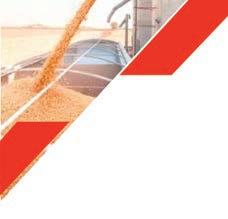




By Diana Yates UNIVERSITYOFILLINOIS
Ateamof agricultural economists,environmentalscientistsandpolicy expertsenvisions a path toward a carbon-neutral agriculturalfuture by expandingthereach ofpolicies designedtopromote low-carbonbiofuelsfor transportationand aviation. In a new paperinthe journalScience, theresearchersproposepoliciesthat wouldreward farmersfor adopting “climate-smart”practices whengrowingbiofuel crops andremove the hurdlesthat currently thwart such efforts.
Climate-smartpracticesinclude techniquesthat buildsoilcarbon,like cover-cropping, nottilling fieldsafterharvest and addingbiocharorfinely groundsilicaterock to soils;andthosethat reducethecarbonfootprint ofcropproduction,like optimizingthetimingof fertilizer application,electrifying farm vehiclesand improvingcrop genetics.
Studies show that,if adopted globally, “climate-smart” farming practicescouldreduce carbonemissions by 4-8 billion tonnesper year, the researcherswrote. To put that inperspective, in 2024, globalcarbondioxide emissionsreachedan all-timehigh of about40 billion tonnes.
“Biofuelmarketscanbe apathway to decarbonize agricultureas a whole,” said Madhu Khanna,a professorof agricultural andconsumereconomics at the UniversityofIllinois Urbana-Champaign andlead authorofthenew report.Khannaisthedirectorofthe Institute for Sustainability, Energy
andEnvironment anda researcher intheCenter for AdvancedBioenergy andBioproducts Innovation, funded by the U.S. Department ofEnergy, at the UniversityofIllinois.
“Currently, ourbiofuel policies don’t reward farmersfor adopting climate-smartpractices,” Khannasaid.“For example, theytreat allcorn grownforthecorn-ethanolmarket thesame, whetherornotthe farmers adoptthosetypesof practices. By accounting fordifferences inpracticesimplemented at the farmlevel and payinga premiumforcorngrown with climate-smartpracticesfor cornethanol, biofuelpolicies can incentivize adoptionofthesepractices.”
Biofuelmarketshave already establishedmechanismsfor accountingfor the carbon-intensityof different feedstock types andhave well-developed channelsfortransferring payments fromenergy markets tobiofuel producers,theresearchers report. Thisopensthe doortousingthese channelstoexpandperformance-based incentivesto increasethe adoptionof climate-smartpractices in agriculture.
“Forexample, the ‘40B’ Sustainable Aviation Fuel taxcredit of2023-2024 was designed todifferentiatethecredit basedon the climate-smartpractices adopted whileproducingthe crop,”Khanna said. “Thelower thecarbon intensity, thehigher the taxcredit paidfor sustainable aviationfuels and forthecropused toproduce it.”
At present,however, the channelsforcrediting farmersforsoil-carbon sequestrationorother cli-

The research work of MadhuKhanna, ACES DistinguishedProfessorinEnvironmental Economics,looks at policy changes that couldlead to aboostinfarmerparticipationinprograms that increasefarmcarbonsequestration.Khannavisits theEnergy Farmnearsomecarbon detection equipment that quantifiescarboncyclingin bioenergycrops.
mate-friendly practicesonthe farmaresegregated

fromthe marketsthat provide creditsforlow-carbon biofuels,Khanna said. To becompensated fortheir sustainabilityefforts ingrowingthe crops, farmers must eitherenroll in a conservationprogramorsellcarboncredits tooneofseveralcompaniesspecializing in agriculturalcarbonoffsets. Spaceislimitedin government conservationprograms, however, and farmers must prove that theyaren’t already engagingin climate-smartpracticesto obtaincredits. Thisrequires a lotofextra effortonthe farmer’s part.
“It alsomeansthat early adopters get penalized,” Khannasaid Khannaandher colleaguespropose an ap-

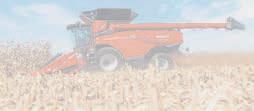
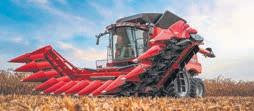

proach formerging the biofuelfeedstock market and climate-offsetmarket into a single channel toreward farmersandothers inthe biofuel supply chain who usepracticesthat lower thecarbon-intensityoftheiroperations. This approach could subsequently bebroadenedto reward farmersfor adopting climate-smartpracticesforcrops to supply food andfeedmarketsas well.
Like existingpolicies, any new approach would require verificationthat farmersare actually implementingthe practices they’ve pledgedtofollow.
“Emergingdigitaltechnologiesandmodeling advancescan document farmingpracticesand ac-
CarboncontinuesonA16







By BusinessWire
Bayer hasannounced that Cornfed Farms,a fourth-generation farm operated by the Mohr family, hasbeen designatedasthefirst Bayer ForwardFarmsiteinthe Midwest andtheonly ForwardFarminthe United States. Thisrecognition placesCornfed Farmsas one of 16 farmsaroundthe globe, highlighted by Bayer ascommittedto advancingregenerative agriculturepracticesthat ensureeconomic success whilepromotingenvironmental stewardship.
Bayer ForwardFarming is dedicatedtopartneringwithselected farms globally toimplement innovative agricul-
turalpracticesthat ensure farmers’ economic success whilepromotingsocialandenvironmental responsibility. Through collaboration,education, andknowledge-sharing, Bayer iscommittedto advancing sustainable agriculturefor a betterfuture.
“We believe that regenerative agricultureisessentialforthefutureof farming, and we’re proud toberecognizedas a leaderinimplementing environmentallysustainable farmingpractices,”said Alan Mohr, owner/operator ofCornfed Farms.
“Being a Bayer ForwardFarmallows usto share ourjourney andcommitment to sustainablepracticeswithother farmers, demonstratinghow
Thisdiversifiedapproachnotonly mitigates economic risksbut also createsasustainablecycle where livestockmanureenriches thesoil, furtherenhancing crop health and productivity.
adopting sustainable farmingpractices canbea win-winforgrowersand fortheenvironment.”
At Cornfed Farms,the Mohr family has adopted ano-till/minimumtill approach, significantly reducing soilerosionand enhancingsoilhealth. By integratingintermediate crops such asCoverCress and camelina,they willbe improvingbiodiversity,

showcasessome of agriculture’s latest cornand soybeanproductsand technologiesincluding thePreceon SmartCorn System,enabling farmers tobenefit from shorter stature hybridsanddatadriven insights that help mitigaterisk andoptimize performance inthe field.
waterretention,and nutrient cycling Theseregenerative agricultural practices notonly protect thesoil duringoff-seasonsbutalsocontribute organicmatterthat benefitsfuturecropyields, whileprovidinganoffseasoncash croptoharvest andfurtherenhance theoperation’s financial viability.
Cornfed Farmsalso
“We areextremely proudtopartnerwith Cornfed Farmsandthe entire Mohr family as they sharetheirexperience, knowledge andbest practiceswithfellow farmers,”saidBrian Naber, Head ofCropScience forthe NorthAmerica and Australia/NewZealand Region for Bayer. “Thiscollaborationemphasizestheimportance ofinnovative agricultural
practicesthat ensure farmers’economic success whilebeingsocially responsibleandenvironmentally conscious.”
In additiontocash cropslike corn,soybeans, the Mohr family runs a diversified farmingoperationthat alsoincludes hay andcattle. Thisdiversified approach notonly mitigateseconomicrisks butalsocreates a sustainablecycle wherelivestock manureenrichesthesoil, furtherenhancing crop healthandproductivity. This,alongwithusingdataand adoptingdigital recommendations,helps Cornfed Farmsreduce the need for syntheticnitrogen andbemoreprescriptive intheir applicationof key inputs.

By Rodrique Ngowi andKimberleeKruesi ASSOCIATEDPRESS
Humansfirst beganforagingforfood some 12,000 years ago, longbeforethey developed agricultural toolsthat overshadowed the ancient act that helped sustainearlyhumans. Yet some chefsandforaging enthusiastssay thesearch for wild mushrooms,edible plants, shellfish and seaweedhasgrownmore popularinrecent years.
Chefslike Evan Mallettof Black TrumpetBistroin New Hampshirearealso sparkinginterest by using foraged ingredientsincreative dishes. The renewed interest insearchingfor wild mushroomsandedible plantsrangesfrom those wantingtobebudget-conscioustothose wantingtobemore mindful oftheir environmental footprint.
Standingbarefootina grassy patch ofdandelions, Iris Phoebe Weaver excitedly beginslistingthe many ways themodest plant canbeusedmedicinally andincooking.
“I just pickeda bunch of dandelion flowers yesterday andthrew themin vodkawithsomeorange peelandsome sugar, and that’s my dandelion aperitif,” Weaversaid. “That willmakea lovely mixed drink at somepoint.”
Alongtimeherbalist and foraginginstructorin Massachusetts, Weaver takes peopleonnature walks that transformtheir relationshipswiththeir surroundings.Lately, she’s beenencouraged by the uptick ininterest inforaging, a trend she seesas benefitingtheenvironment, communityand people.
“Thereisjust anamazing amount offoodthat is
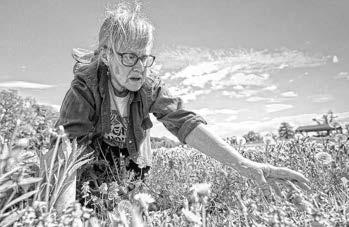
aroundus,” Weaversaid. “Thereisso much abundancethat we don’t even understand.”
Humanshave beenforaginglongbeforethey developedthe agricultural toolssome12,000 years ago that quickly overshadowedtheancient act that helped sustainearlyhumans. Yet foraging enthusiastssay the search for wild mushrooms,edible
plants, shellfish andseaweedhas grownmore popularinrecent years as peopletouttheirrare finds.Others shareknowledge onsocialmedia,and experiencedforagersoffer trainingtonovices onsafe and sustainablepractices.
The renewed interest rangesfromthose wanting to bebudget-conscious— foragingisfree afterall— to those wantingtobe
moremindfuloftheirenvironmentalfootprint.Some evenuseforagingas a creative outlet,using mushroomstheyfindtocreate sporeprintsandother art.
The popularityisalso helped by thehobby’s accessibility. Foragerscan lookforwildfood everywhere, fromurbanlandscapesto abandoned farmlands to forests they just needpermissionfroma
private landownerortosecuretheright permit from astateorfederal park. Some advocateshave even launched a map highlighting wherepeoplecanpick fruitsand vegetablesfor free.
Gina Buelow, a natural resourcesfieldspecialist withthe Iowa University ExtensionProgram,says the universityhashada backlogoffolks eager to learnmore aboutforaging mushroomsfor thepast two years. Buelowruns presentationsandfield guide days throughoutthe state, regularly meeting the attendancecap of30in both ruraland urban counties.
“Typically, I would get usually older womenfora mastergardenerorpollinatorgarden class. That audience still shows up to these mushroomsprograms,butthey bringtheir husbands.And a lotof peoplebetweenthe agesof 20 and 30 yearsoldare really interestedinthis topic, as well,” she said.
Somecreative chefsare alsosparkinginterest in foragingastheyexposepatronstoexoticand surprisingly tastyingredients
foundlocally.
“Foragingisan ancient concept,”said Evan Mallett, chefand ownerofthe Black Trumpet Bistroin Portsmouth, New Hampshire, a popular historic New England destination. “Ourculturehasmoved far away from foraging and isfortunately coming back into it now.”
Mallettopenedtherestaurant nearly 20 years ago and usesfoodsforaged fromaround Portsmouth. He said hehopesmore peoplewillcontinueto learn aboutforaging, and encouraged those worried aboutpickingsomething poisonoustofind a mentor.
“I thinkthedangersof foragingarebaked into most people’s brainsand souls,”hesaid.“We asan animalknow that thereare certainthings that when theysmell a certain way or look a certain way, they can beencodedwitha message that we shouldn’t eat thosethings.”
Mallettnamedhisrestaurant afterthewildforaged mushroom as a reminder. Overthe years, he’s incorporated Black

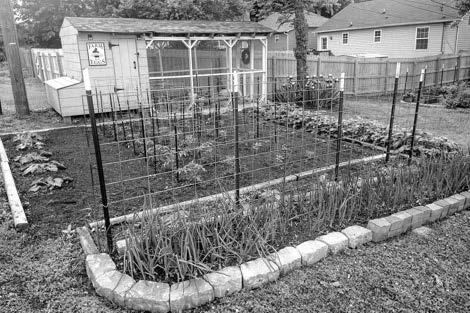
By Leanne Italie ASSOCIATEDPRESS
Thinking aboutbackyard chickensasegg prices soar? Thinkhard,especially inlight ofthe bird flu outbreak.
Keepinghome chickens as a pastimehascontinued togrow sincethepandemic. But if eggs arethe goal,rememberthat it takes planningand invest-
ment toraisethe chickens and protect against bird flu.
“Anyone who’s donean ounceofresearch will very quickly understand that therearenofreeeggs,

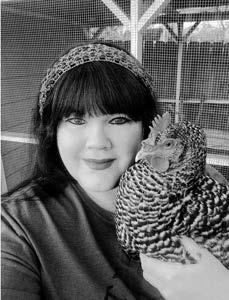
there arenoinexpensive eggs in keeping chickens,” said Kathy Shea Mormino, ahome chicken blogger and author who has about 50 ofthebirds at her home.
“You’re goingtopay more, particularly in your first several years,in your set up andin yourbirds. And there’s a huge learning curve onhow tocare for animalsthat are really unusualpets,”said Mormino, who has kept chickens for 15 years andcalls herselftheChicken Chick. Costs vary wildly, from about $200to $2,000fora coopalone. Feeders and waterersrange from about $8 to $50 ormore, depending onthesizeandtype.
Bird flu hasforced farmersto slaughtermillionsof chickens a month, contributing (alongwith inflation) tothe steepprice
of commercial eggs and resulting in somescantily stocked storesaroundthe country. The scarcityand high pricesare causing sometolookfor a backyardalternative.
“We’ve seen a real uptick in callsrecently from people wantingto start their own backyard flocks. Withthe egg shortages at grocery stores,many are excited aboutthe idea of raising chickensandtaking stepstoward sustainability,”said Matthew Aversa, a co-ownerof WindingBranch Ranch,a nonprofit sanctuary and farmanimalrescue.
“We adoptout whole flocks. We’re receiving at leasta dozen inquiries per week,”hesaid.
Kate Perz, theanimal sciencecoordinatorfor CornellCooperative Extension of Suffolk County,
New York, saidthat unlike other pandemicpastimes, raisinghome chickenshas only grown.
“It’s notalways cost-effective,” she said.“You have toreally look at how many eggs you’re eating and what thecost ofthose are versus what you wouldbespending.”
Thereare other reasons,ofcourse, to keep chickens at home, notthe least of which isthe sheer joy oftheirpresence. Morminoandother “chickeneers,”as she callshome enthusiasts,have a coop fulloftipsonhow to get started.
Tend to legal matters
You may be ready to dive right in. Yourtown may not. Mormino, who wrote “TheChicken Chick’s Guide toBackyard
EggscontinuesonA15
Chickens,”saidthefirst thingtoconsideris whether chickensare right for you.Afterthat, don’t assume yourcounty, townorcitywillallow it.
Look up zoningand buildingcodes yourselfif you feelcapable Otherwise, consultan attorney who specializesin municipallaw in yourarea.
Don’t rely on wordof mouthor even a town workertoknow theins and outs.Is a building permit requiredtobuilda coop?Areroosters bannedundernoiseordinances? Sometimes,zoning codesaresilent onthe subject. Don’t assume that’s a greenlight Many codes are “permissive use” regulations, Mormino said, essentially meaning that ifthecode doesn’t say you’repermitted, you’renot!
If chicken-keepingisallowed,isthere a limit on how many birds? Are thererestrictionson where a coopcanbebuilt in relationtoneighboring propertylines. Most homeownersassociations have rulesonanimal keeping.
Morminolives ina farmingtownandhada neighbor who keptthree horsesand a small flock of chickens,so she assumed they werelegal. They weren’t She calledthe town clerk’s officetoask whether a buildingpermit was requiredtobuild a coop and was told it wasn’t. It was.
In theend, she successfully defended a lawsuit against her (she’s an attorney) andprevailedina longbattletoamendthe law, legalizing backyard chickensinhertown.
Whatabout bird flu?
Bird flu ishighly contagious. It spreadsmostly
by migrating waterfowl in theirdroppings.Chickens are far fromimmuneif theyspendany timefree ranging orin a run without protectionfrom wild fowl droppings.
“There’s a limited number ofthings that we can do becauseourbirdslive wherewildlifelive,” Morminosaid.“People needto know iftheyhave a birdor birdsthat die suddenly fromsomeofthe symptoms,theyneedtocontact the USDA to get thepostmortemexamandthe birdstestedforbird flu.”
Don’t bringsick birds intothehouseforcare. That raisesthe risk of transmissionto humans. Oncethevirus isconfirmed,theentire flock needstobeeuthanized, she and Perz said.
Symptomsofbird flu include: sudden death withoutany clinicalsigns; swellingofthe head, eyelids,comb, wattlesor hocks; diarrhea; stumblingor falling down; decreasedegg production and/orsoft-shelledor misshapeneggs; and coughingand sneezing.
Don’t feedany wildlife in areas where your chickens dwellorroam Wash handsthoroughly after tendingto chickensand dedicate a pairof shoes or boots strictly foruse aroundthem.
“Thebiggest mistake backyard chickeneers make istobringnew chickensinto their flock that have lived someplace else That’s the fastest way to bringdiseaseinto your chicken yard,” Mormino said.
Consider yourcosts
Sarah Penny has turnedher 7,000-squarefoothomelotin Knoxville, Tennessee, into a beautiful gardenand chicken home. She hasninebirds and grows more thanhalf the food she and her 13year-oldsoneat.

She’s had chickens since 2021 and estimates her startup costs atabout $2,500.
Monthly costs vary basedon what chickens
are fedand how coops are kept. Penny, forinstance, uses the deeplitter method and compostsfromher coop,meaning she’s not muckingouthercoop more than twicea year.
“But the cost of starting with backyard chickensis definitely quite expensive. Idon’t know if a lotofpeople know that,” Penny said.
Her coop alone, which her family built themselves,cost about $2,000. It had to beoutfitted to keep predatorsout, includingrats that tunnel under theground.
Many people startwith buyinghatchlings, which just got moreexpensive to ship via the U.S. Postal Service due to new fees. Raisinghatchlings requires a chick brooderinvolving a separateenclosure, heat lamp,feeders and other supplies.
Penny buys a bag of feed every two weeks for $15 to $20a bag. There’s also the cost ofcalcium, such as oyster shells,and grit to aid digestionif chickensarenotfreerangingor getting those elementsintheirfeed.
She estimatesher monthly costs atabout $60, saving a bit by also feedingher chickens healthy humanleftovers. She’s carefulnot to include foods that are toxic for chickens,including onions, potatoesand avocados.
It’s all worth it to Penny.
“We eata lotofeggs,” she said. “We probably go througha dozen every two days. We bakea lot. We’re aningredient household,sothemajority ofourfoodiscooked fromscratch.Eggs area main stapleforour breakfast.”


By HannahSpangler FARMWEEK
Appleseasonarrived at TannersOrchardinSpeer, alongwithanunexpected socialmediacelebrity
Aforgottencup labeled, “Angela’s do notuseor take,” was left inthe MarshallCountyorchard’s melondisplay inlate August, catchingthe attentionofco-owner Jennifer Beaver.
“I saw what was written on it, and I was laughing, because I couldrelateso well,”Beaversaid.
She snapped a photo and posted it to Facebook, thinking it wouldbea good,lightheartedmoment to sharewithothers. Beaverinitially plannedto post just onephoto, but attentiontoAngela’s cup, whose ownerremainsa mystery, flowed over.
“It seemslike if it’s an organicthinglike that, that’s usually whatit does,” she said.“It was not planned at all.”
Withengagement coming fromout-of-stateusers and non-followers,Beaver decidedtobuildonthe momentum. Withhelp fromher administrative assistant, JessiePyles, additionalphotosofthecup weretakenin various
Frompage A11
curately calculatetheir carbonintensity. Thiscan simplifyandscalethis process,”saidBrunoBasso,a co-authorofthe study andanexpertin modeling anddigital agriculture at Michigan State University. Certification programscouldallow independent verification that feedstocks were sus-

A forgottencuplabeled, “Angela’s do notuseortake,”
melondisplay.
spotsaround theorchard.
The Sept. 3 post ofthe cup brought inmorethan 1,000likesandnearly 50 shares,withsome Facebookusers evencommentingthey wereplanningvisitsfrom other states. Still, Beaver said it’s important toletviralmo-
tainably produced. Calculatingthe changes inthe amount ofcarbon sequesteredincropsoils precisely each yearisa moredauntingtask, the authorswrote But “using multipleprocess-based ecosystemmodelscan reducetheuncertainty in theseestimatesand avoid the needforlabor-intensive soilsamplingprocedures,”Basso added.
Another concernisthe chancethat farmerswill
ments run theircourse.
“With Angela’s cup, we had noideathat would happen,”Beaver said.
“Butthethingthey also have toremember, like withAngela’s cup, it only lasts, you know, for a little bit,and thenpeoplemove on tothenextthing.”
implement andthen abandon various climatesmart practices,Khanna said.
“If they do it one year andnotthenext,they’ll sequesterthecarbonand then,perhaps,release it back tothe atmosphere thefollowing year,” she said.“But we can design incentivesforlonger-term soil-carbonsequestration by having farmerssign longer-termcontracts. This wouldrelatethesize
tion strategy, Beaver still adds a personaltouch through informal updates and now Angela’s cup.
“It’s nicetohave bothon your Facebookpage,”Beaver said.
Beyondsocialmedia, the orcharduses ZIPcode datacollected at checkout to guide its marketing strategy. This fall,they’re targetingareas such asthe Quad Citiesto attractvisitorswillingtomakea day trip. Beaver saidthat in timesofeconomicuncertainty, familiesoften skip vacationsbut stillseekaffordableoutings, which makes agritourism destinationslike theorchard especially appealing.
She said at first the goal was to get day trippersto the orchardin August for their events. It isnottheir typicalpractice to advertiseinSeptemberandOctober, butthey decidedto try “something a littledifferent.”
Now in its 78thseason, TannersOrchardhaslong embracedsocialmediaas partof its marketing strategy, using a Peoria-based marketing agencytopromotetheorchardonline. Whilethe agencyhandles scheduledpostsandthe Search EngineOptimiza-
ofthepaymentstohow longthe farmer agreesto keepthat carboninthe ground.”
Khanna acknowledges that thecarbonbenefits fromexistingbiofuelsare controversial.Somecriticsarguethat devoting farmlandtotheproductionofplant-basedfuels takes up landthat canbe used forfoodcropsand cancontributetotheconversionofforeststocroplandinotherpartsofthe
ful planning, she said. Weekdays tendtodraw shoppersandschool tours, while weekends bring familiesfor apple picking, food standsand the “Back 40” play area. Beaverjoked she particularly looks forwardto openingand closingday at the endof November, but she really looks forwardto seeing familiar families every year. For many families, a visit to TannersOrchardis a tradition passed downthrough generations.
“Watching a family comeoutand it’s just mom and dad,andthen,allofa sudden, it’s momanddad withtheirkidsandthen it’s mom anddad with theirkidsandgrandkids ... it is a lotoffuntosee these families growing,” she said
“I said,‘We needto get thesepeoplefromtwo hours away tocome toour farm,’”Beavertold FarmWeek. “And I said,‘So we needtopulltheminthe fall.’”
Balancingtheorchard’s roleasboth a working farmandan agritourism destinationrequirescare-
world,erasing its sustainabilitygains.
But current approaches couldbeunder-or overestimatingthecarbon benefitsofbiofuels by disregarding the carbon effects ofcrop management practicesimplementedonthe farmproducingthecrop for thebiofuelmarket.
“By developing a market for agriculturalproductsthat accountsfor all thedirect and indirect carbonemissioneffects
As familieshead to Tannersthis fall,Beaversaid the applecrop is “doing well” thanks totimely rainfallin August. Current varieties availablein the farmmarket andfor you-pick include Cortland and McIntosh,withGolden Delicious, Jonathan and anearly Fuji variety comingsoon. As ofpress time, Honeycrispand Gala are still availableinthe market.
fromthe farmtotheconsumer, we canbetter addresstheseconcerns,” she said. “Themainpremise ofourproposalisthat we needtohave a full and accurate assessment ofcarbon emissionsfromthe beginningtotheend of any product’s lifecycle. Andright now, the way that biofuelpoliciesare designed,theytreat crop producers supplyingcrop for a biofuelasallbeing thesame.”
log thecollection’s 100,000corn stocks, leveragingtheir deep knowledge ofthe genes and traitsrepresentedin eachstock to advise requestorsandpack seeds for shipment. Theyalso grow the stock collection on a 12-yearcycle toreplenish fresh seeds. It’sa big job for a few very specializedexperts,but it works.
‘You touch it, you breakit’
Despitethe stock center’s efficient,smoothoperation,low operating costs,andindustry support,thecorn genetics communityisconcerned aboutthe facility’s future. That’s because, inearly June, theARSlocationin Urbana which operates boththe MaizeGenetics Cooperation Stock Center and the NationalSoybean GermplasmCollection— appearedon a shortlist of ARS facilities slatedfor

closureandconsolidation as partoftheproposed 2026 USDA budget. Under theplan,the stock center wouldbe consolidatedwith the NorthCentral Regional Plant Introduction StationinAmes, Iowa.
The survivaloftheinvaluablecollection dependsonseedsheld at precisetemperature and humiditysetpoints. Transporting 100,000 stocks andbuildingthe required facilities ina new locationpose real

pertise, infrastructure, and institutionalcontinuity in Urbanaisunmatched andirreplaceable I also question whether NCRPIScanrealistically absorb the stock center without substantialinvestmentsinboth facilitiesandpersonnel. Relocating it woulddisrupt ongoingresearch andput aglobally uniqueresource at risk,” Bohn said.
“In my view, if you touch it, you break it.”
ate appropriations committee, withfullCongressional votestocome. In the meantime, advocates continuetomake their case against consolidation.
challengestothecollection’s integrity. Andexpertsarguethere’s littleto no benefit toconsolidation.
“The stock centeris historically rooted at the UniversityofIllinois,and the concentrationofex-
Legislatorsandindustry groupsare voicing supporttomaintainthe threeARSlocations facing consolidation,resulting inreportlanguage fromthe House appropriationscommitteethat it “rejectsproposedresearch programterminations.” USDA’s proposal torelocate, ratherthan terminatethecollections and programsoutright, may renderthat advice moot, however. The USDA budgetandany enforceable statutory language relatedtorelocationarecurrently under consideration by theSen-
Brad Stotler, director of government affairsforthe IllinoisCorn Growers Association,isone of those advocates.“Relocating the collection risks the loss of criticalinstitutional knowledge and slows progress on research that benefitsAmerican agriculture all at significant and unnecessary expense,” he said. “The ARS facilityin Urbanaandthe uniquecollections of soybeansandmaize housed therearecritically important to advancing genetic research andimproving American agriculture. The maizecollection has 72 yearsofhistory onthe Illinoiscampus,and it’s moreimportant than ever to invest intheseprogramsandprotectthe well-establishedresearch collaborationbetween ARS and U of I scientists.”

FrompageA4
stillimportant tome. It’s like what theysaid:'People raisebuffaloes,and buffaloesraisepeople.’ It’s likea family member.”
As hobby farms surge inpopularity inthe U.S., thenumberofpeople claimingcows, pigs or goats aspetsalsoisgaining.
“Myhusband actually had cows for a while,” Charlesworthsaid.“He hada bull. He broughtit tothehouseand I named it Frank. He’d say, ‘You can’t messwiththat bull’ —hewas worriedhe would hurtme.But Frank loved me.”
With aHighlandcow asherbusinesslogo, one might think it wouldbe Charlesworth’s favorite animal,orthat onemight beamongherlesscommon pets.
“Honestly, the whole aestheticforthe store was Boho western-themed,”
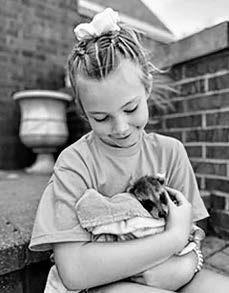
CourtesyofJennyCharlesworth
ReesCharlesworthholds Willow, ababyraccoon owned by hermother, JennyCharlesworthof Concord. JennyCharlesworth, whosaid she'salways wanteda raccoon, got the requiredlicenseand bought Willowfromabreeder.
she said. “That just kind ofcametomeand I really liked the Highlandcow.I went tomarket in Texas and that kindofbrought it alltogether.”
She seestheirony of havingoneofthefew animals she doesn’t own so closely linkedtoherbusiness.
“Thefunny thingisI actually went toEngland twice, andScotland was so closeand I wantedto go see the Highlandcows and haven’t made it,” Charlesworthsaid.
Her “favorite” animalis far moretypical.
“Cats areprobably my favoriteanimal,”she said. “Butany livingthing,I gravitate toward.”
Almost.
“Ihaven’t had a monkey,”she said.“Because theythrow theirpoop andIdon’t think I could handle that. That’s where Idraw theline.”
The Associated Press contributedinformationfor thisstory.
FrompageA5
Sauer-Schmigdall’s daughter, as well. She saidher daughter“always wants to work with“ her and her husband and she was thankfulherdaughter was abletohave thesameopportunities as her.
“I loved beingonthe farmwith my dad, butI don’t everremember being the way she iswithus,” Sauer-Schmigdallsaid. “She wants tobeonthe tractorwithus all the time.”
ter, andthenthe clean water was sittingontop.
“I was jumping up and downinthislab by myself becausethis was during COVID.”
Withearlysupport fromtheiVenture Accelerator at the U ofI,Bailey founded Agriwater, which transformslivestock manure waterintocommercially valuable byproducts.
Afterearningher doctorate, she securedfunding from the Department of Energy andOakRidge NationalLaboratory in Tennesseetocommercialize thetechnology.
Today, Agriwateris backed by anangelinvestor, Techstars Water Tech &Sustainabilityandthe
AgTech gBetaof Gener8tor, propellingthe company towardscaling its impact.Since its launch, Agriwaterhasraisednearly half a million dollars, expanded its team, and won multiple awards, includingthe2023 Climate TechInclusion Award from EvergreenClimate Innovationand U.S. Bank. Now, Agriwater is gearing up for full-scalemanufacturing, delivering its manure-to clean water systemstoearly adopters, and raising a pre-seed funding roundtotransform waste into value at scale.
The AFBF Ag InnovationChallenge is a chance for Baileytotake thecompany tothenextlevel.Entrepreneurs present toa panelofjudgestheir emergingideasandbusinessesinthe agricultural
industry, with a chanceto earn $100,000in startup funds.AFBFisofferinga totalof $145,000infunding throughoutthecourseof the competition.
“I want tobeonthat stage, and I want totell everybody what I’m doing. That’s the goal,”Bailey said, adding she’s applied for the awardseveral times.“It just goesto show it’s aboutendurance, and you have to just keep trying.”
One ofthebenefitsfor farmerswiththetechnology, Baileysaid,is it will ease the burdenof clogged irrigation lines for producers who usemanuretoirrigate.
“We canremove thesolids from the manureto have a better, smootherirrigation process,”Bailey said. “Also, we canhelpreducethepotentialofleach-
ing toxicmanureintothe riversthat willhelpwith environmentalcompliance Andfor thedroughtproneareaslike California and Arizona,being ableto produce clean water from manureonsitewillhelp themwithdrought, as well as reducingthecost of themhavingtopay for water to be pipedintotheir farm.”
Cost savings on water billsandfertilizeralsoare benefits.
“Andas we’re cleaning this water, we’re actually reducingtheamount of greenhousegassesthat are escaping, because it’s not just sittingoutinthe open,”Baileysaid.
Bailey’s visionfor the company istohave Agriwateron every livestock farm.
“Our tagline is ‘turning poopintoprofit’,” she said.
Frompage A13
Trumpet mushroomsinto dozensofdishesthroughoutthemenu— evenice cream.
Othermenu itemshave includedforagedsea kelp inlobstertamales,as well asusing Ulva lactuca,a typeofsealettuce,insalads.
“It’snothingthatInecessarilyseekout,butI kindoflove itwhen it’s on amenu,”saidM.J. Blan-
FrompageA7
keepatractorwithadisk nearby;schedulebreaks; andcall 911 right away if necessary.
“Dry vegetationin fieldsandwildlandareas createshighfuelloads thatcanignite quicklyand spreadrapidly, putting farmers,nearby homes, and surroundingproperty at risk,”saidIllinois
”I’m not ashamedof growing up on a farm,” she said.“Not by any means.”
Sauer-Schmigdallsaid her rural upbringing made her strong instead of being distracted by “lights and flashing big things and huge homes and clicks.” Growing up on a farm also made hermoreconfident in herself and willingto understandothers better, to the point that herfriendliness is notable in a big city such as Los Angeles.
“It opened my eyesto what real living is andnot smoke andmirrors,” she said.
Boldt and SauerSchmigdall had both been shaped as adults by their rural childhoods.Boldt said growing up on a farm leanedtowardscommunity involvement by necessity because farmers and their families keepthe nearby smalltownsfunctioning. She alsosaidthat growing up on a farm strengthenedher faith in God becauseofthe“ifs, ands, butsandmaybes” about life onthe farm.
chette,alongtimepatron of Black Trumpet,speakingtotheforageddishes available at Black Trumpetandotherrestaurants.
Sherecentlyordered themeatballswithforaged sweetfernfrom Mallett’srestaurant,afeature shesays elevatedboththe tasteandexperienceof consumingthedish.
“Ithink it’s reallycool andIthink it’s alsosomethingthat’snotonlyforaged,butalsotendstobelocal,andIlikethatalot,” shesaid.
State Fire Marshal Michele Pankow.
Albanosaidpeoplecan makedrought reportsto helptrack the weather by clickingthelinksintheir drought reports, which canbefound at weather.gov/ilx/DroughtInformationStatement.
“Everybodyknows that we’reallinthesameboat,” Whitesaid.“It’sjustthe luck ofthedraw whether ornot youhave afirein thenext yearorso.”

